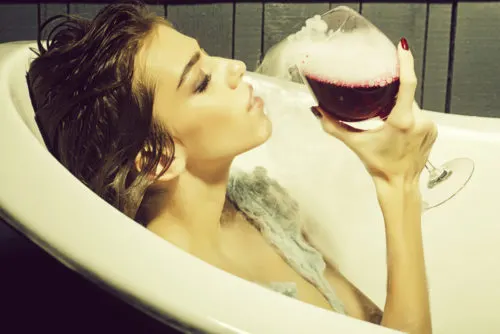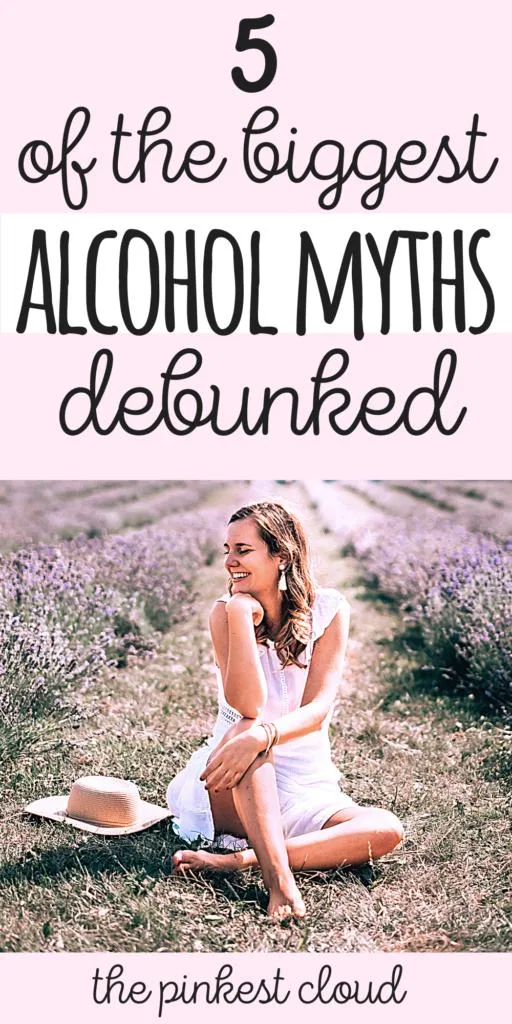Alcohol is such a prominent part of American culture.
It is literally everywhere.
From tailgating events and frat parties in college, to swanky corporate holiday gatherings at work, to epic girls’ trips to Vegas and beyond – alcohol consumption is highly normalized.
In fact, you’re left looking like the oddball if you don’t drink.
Since drinking is perceived as a normal part of standard adult life, many who do drink don’t take it seriously.

This is partially due to all the false information floating around out there about alcohol.
Of course, you can excuse and reason your way through your problematic drinking behavior when you receive a steady stream of information that tells you it’s normal or okay.
Today we’re going to debunk 5 common myths about alcohol use.
We’re going to talk about the things we’re told are normal and okay but are really anything but.
RELATED: 7 Reasons To Cut Back On Alcohol (Even If You Don’t Quit)
Alcohol myth #1: Different types of liquor are better than others
There is this false belief floating around that some types of alcohol are better or worse than others. Sometimes declarations of sobriety are even met with “you don’t drink? Not even wine”?
No, not even wine, because wine is alcohol, too!
Some people swear that dark liquor is the devil because it makes them angry, but clear liquor leaves them a happier buzz. Others contend dark liquor is healthier than light, due to higher antioxidant content. Still others insist beer is softer or lighter than hard liquor, therefore better at preventing hangovers or “not as bad”.
While some of this may be true… it’s only a small piece of the big picture. You have to tell the whole story if you’re gonna tell it.
Here’s the real deal:
Dark liquor makes me angry: One explanation is that this is likely a placebo effect. This study found if you expect dark liquor to make you angry, it most likely will.
Dark liquor is healthier than light: While dark liquor does contain more antioxidants than its lighter counterpart, it also contains congeners – toxic chemicals that actually worsen hangovers. If you want an antioxidant-rich drink, try tea… not tequila.
Beer and wine are softer than hard liquor: It all boils down to alcohol content and amounts. Yes, there’s less alcohol in beer and wine than in your average shot of vodka or whiskey, but if you’re drinking multiple beers or glasses (or bottles) of wine – you’re not doing yourself any favors.
By the time you’re making excuses for degrees of horribleness of the beverage you’re consuming, you’re already past the point where it’s unhealthy anyway. Let’s be honest.
RELATED: 8 Mistakes To Avoid In Early Sobriety
[amazon box=”1912023385″ template=”horizontal”]
Alcohol myth #2: People can’t tell you’ve been drinking
If you’ve ever gone out on a bender or had a long, liquor-filled weekend and actually made it to work Monday morning, maybe you’ve thought nobody could tell. You woke up, showered, brushed your teeth really good, threw on a little makeup, drank some coffee and pulled yourself together convincingly enough – or so you thought.
Let me tell you just how strong the smell of alcohol is to those who don’t drink at all. If you drank even moderately within the past 12 hours or so – somebody knows. You’re not fooling anyone. Not even yourself.
RELATED: 5 Things Nobody Tells You About Early Sobriety
[amazon box=”1984317792″ template=”horizontal”]
Alcohol myth #3: Everybody drinks
The 2015 National Survey on Drug Use and Health (NSDUH) reports that 86.4% of US adults reported drinking alcohol at some point in their life.[1] This, coupled with the overwhelming need to come up with excuses for why you’re not drinking, may lead you to believe that everybody drinks. Understandable.
But statistics from the same study also show that only 70% reported drinking in the past year, and 56% in the last month. Just over half. So yes, most people have drunk ever, but the amount of people who regularly drink is significantly fewer.
Most people really don’t drink all that much. It’s not as common as it seems.
[amazon box=”1984825070″ template=”horizontal”]
Alcohol myth #4: Blackouts are normal
In her 2010 smash hit, Last Friday Night, the songstress excitedly croons “It’s a blacked out blur, but I’m pretty sure it ruled, Damn.”
Yes, this is just a fun song about a wild and free Friday night, but it is evident of the general attitude surrounding alcohol-induced blackouts.
Blackouts are frequently confused with passing out. To clarify, passing out is when you drink too much and go to sleep. Blacking out is when you’re up, moving around, talking, and doing things, but none of these actions are imprinted on your memory. Part of the danger from blacking out is that others may not be able to tell you’re not really “there” because you appear conscious.
Though fairly common (one study showed that half of college students surveyed had experienced a black out at some point), a blackout is not just a forgetful stage of drunkenness along your journey from sober to shit-faced.
Health risks during blackouts include (but are not limited to):
- Getting into fights and arguments
- Blurred lines of sexual consent
- Engaging in risky behavior (like drinking even more or doing additional drugs)
- Getting into accidents or other dangerous situations (robbery, assault)
Alcohol myth #5: Alcohol in moderate amounts makes you healthier
We’ve all heard this before, and it certainly comes in handy for those who just can’t fathom the thought of parting with the thought of wine and cheese. But new guidelines have established that contrary to popular belief, when it comes to cancer, no amount of alcohol is safe.
Obviously the more you drink the higher the risk. But it was previously thought that alcohol in moderate or small amounts provided health benefits. It is now known that any benefit is negated. Alcohol is a carcinogen, and even light alcohol consumption causes cancer.
[amazon box=”B018IQAW5K” template=”horizontal”]
5 Common Alcohol Myths – Debunked

Alcohol is a tricky beast. When used responsibly, it can be a pleasant addition to social gatherings, meals and outings. But in many cases the risks outweigh possible benefits.
You have to decide for yourself how much risk you’re willing to take on, and to what end?
Get your priorities in line, stay informed, and the only influence you’ll be under is that of your own choosing.
More Sobriety Ideas For You
- 4 Ways To Exploit The Pink Cloud Of Early Sobriety
- 31 Inspirational Quotes To Help You Stop Drinking Alcohol
- IWNDWYT & ODAAT — What Do They Even Mean?
Save This Article For Later
[1] Substance Abuse and Mental Health Services Administration (SAMHSA). 2015 National Survey on Drug Use and Health (NSDUH). Table 2.41B—Alcohol Use in Lifetime, Past Year, and Past Month among Persons Aged 12 or Older, by Demographic Characteristics: Percentages, 2014 and 2015. Available at: https://www.samhsa.gov/data/sites/default/files/NSDUH-DetTabs-2015/NSDUH-DetTabs-2015/NSDUH-DetTabs-2015.htm#tab2-41b. Accessed 8/2318.
